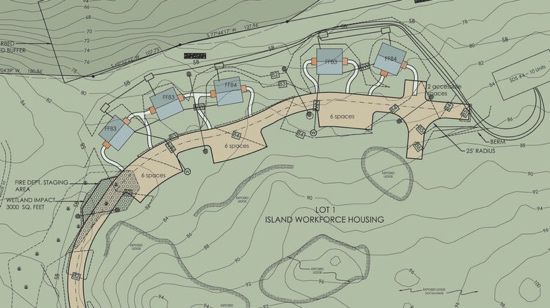As Maine continues to wrestle with a growing income disparity and a housing crisis that stretches across the state, Megan Wood, of Deer Isle, is working to pick up where her father left off, building badly needed housing to keep workers living in town — and the community where she grew up whole.
“If we don’t take action now, we risk losing so much more of our community,” she said.
Wood is board chair of Island Workforce Housing, a nonprofit founded by her late father, Mike Wood, to create housing in Deer Isle and Stonington for those who earn a living in service jobs, but might not normally be able to afford to live on the island. Megan Wood said the nonprofit has finally broken ground on a $2.8 million project to build five two-unit duplexes in Deer Isle.
“We’re so excited to actually have these houses in the ground,” she said.
Deer Isle, just southwest of Mount Desert Island, along with its two communities, the towns of Deer Isle and Stonington, is becoming less and less affordable to those making the local median income — $58,345 for a household and $30,926 for an individual.
According to data from MaineHousing, the median sales price for a house in 2020 was $346,000 in Deer Isle and $302,500 in Stonington. Meanwhile, an “affordable” home for a median-income household was $259,950 in Deer Isle and $179,695 in Stonington.
In 2021, Wood said, things weren’t any better. The median house price in Deer Isle increased to $350,100, but a median-income household could still afford a home priced at $244,811. In Stonington, she said, the median home price soared to $360,000 in 2021, with an affordable home for median incomes jumping to $208,537. The impact, she said, has been obvious.
“A lot of the people I grew up with have moved off-island,” she said.
The situation made headlines in August 2021 when the Island Nursing Home, which had served local communities for 40 years, had to close its doors. The home’s board of directors told multiple media outlets at the time that the principal reason for the closure was a lack of available workers in the area. Wood said the home’s residents had to be transferred elsewhere in the state, meaning families had to travel as far as Bucksport and Hampden to visit loved ones.
“It’s really tragic. It really tears at the fabric of our community,” she said.
Like similar topics relating to housing, an official definition of workforce housing is difficult to find, in part because that definition is influenced by economic factors that vary widely across the country, and from community to community in Maine.

One definition comes from the Urban Land Institute, a Washington D.C.-based research and education nonprofit focusing on issues surrounding real estate. The definition appears in a report the institute produced in 2010. In a section labeled, “Defining the workforce,” the report’s authors wrote: “While the question of how to define workforce households remains heavily debated, for the purpose of this study we define workforce households as those with incomes between 60% and 100% (of area median income), adjusted for household size.”
This report from the National Association of Realtors uses the same definition, even citing the institute as its source, modifying the figures to 60% to 120% of area median income.
Similar definitions exist in Maine. In Portland, where local ordinances require construction of new rental apartment units that dedicate a portion of available space to workforce housing, the city’s website uses similar language. Portland describes a workforce rental unit as being affordable (meaning, not costing any more than 30% of a tenant’s monthly gross income) to a household earning up to 100% of the area median income. A workforce unit, according to the site, must be affordable to a household earning up to 120% of Area Median Income (AMI).
Wood said her project is geared toward tenants who make between 61% and 120% of Hancock County’s median income. Her nonprofit will manage the duplexes, making sure they cater to people like nursing home workers, police officers, firefighters, EMTs or teachers who wouldn’t normally be able to afford living on Deer Isle.
“This is for the working force,” she said.
Well-meaning efforts to produce more affordable workforce housing can sometimes create problems. In Portland, a citizens’ initiative that passed last fall has pushed the required number of workforce housing units in new rental properties to 25%, which some predict will drive market-rate development out of the city.
Dan Brennan, director of MaineHousing, said there’s also a risk of making what is sometimes an artificial distinction between “workforce” and “affordable” housing. The latter, he said, more accurately described as subsidized low-income housing, has an inaccurate and unfair stigma attached to it that it only caters to drug addicts and the unemployable.
“A good number of people who have (Section 8) vouchers are in the workforce,” he said.
Brennan added, however, that he strongly supports work like what Wood is doing through Island Workforce Housing.
“I applaud what they’re doing. I think it’s fabulous,” he said.
Wood said municipalities in her area are excited about the investment too. Local communities, she said, have offered funding, and local contractors have offered to volunteer time to help with construction.
“The support from our local communities has been immense,” she said.
Wood often uses the word “community” when describing her organization’s work. For her, it’s not just about finding homes for people. It’s about holding the fabric of her home town together.
“What do you need to have a community? Housing. That’s at the forefront of our work,” she said.



